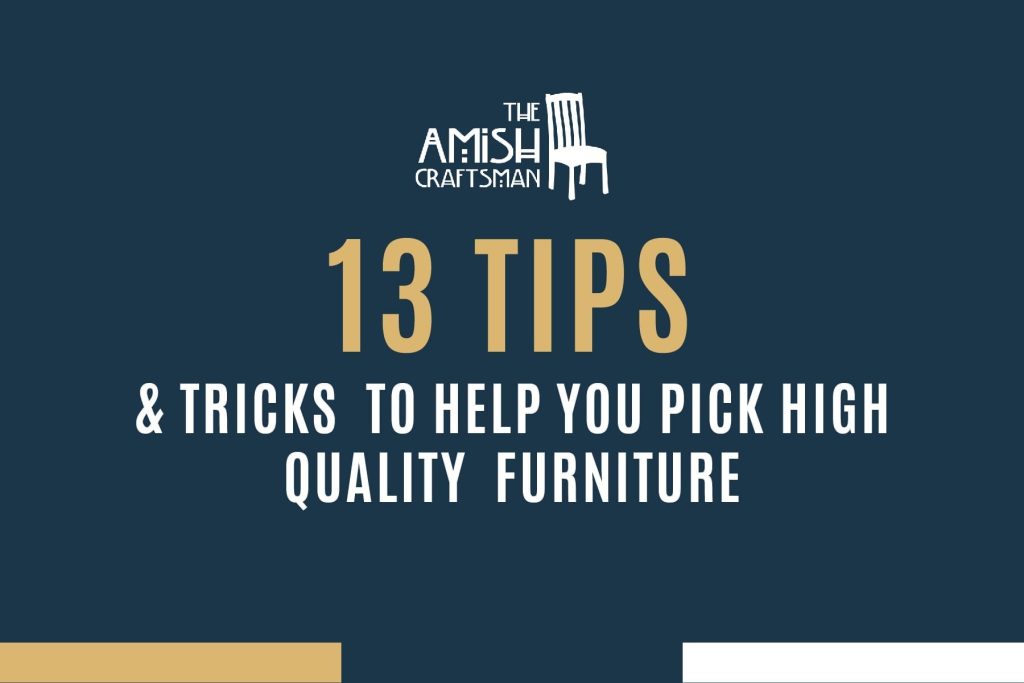We have all experienced it – the new furniture we were so excited about begins to fade, crack, or fall apart after only a few years.
If you purchased the flawed furniture at a high-end furniture store, or if it was handcrafted furniture, this is especially disappointing.
When we think we have high-quality furniture, only to discover it was a fake facade, we promise ourselves we won’t fall for cheap furniture again.
So what should you look for to ensure you do find furniture that lasts a lifetime?
Here are 13 tips & tricks to ensure you get only the highest quality furniture. Browse the list, or click a link to go directly to that tip. These tips are all combined in an infographic at the end of the article as well.
Happy shopping!
- Is it Solid Wood?
- Does it use Mortise & Tenon Joints?
- Does it use Dowels?
- Look for Dovetailed Joints
- Does it have Reinforced Block Corners?
- Do drawer glides run smoothly?
- Use the “Hip Test” for Wobbles
- Check the finish
- Look for chips or cracks
- Is the Upholstery Sagging?
- Is Low-density Foam used?
- Check for Scratch Resistance
- Watch for Click-bait Terms
- Infographic
Is it Solid Wood?
This question may seem a bit odd. After all, isn’t anything labeled “wood furniture” going to be solid wood?
Sadly, no!
Many furniture manufacturers, including do-it-yourself kits, use a combination of plywood or veneer to give you the false impression that the furniture is real wood.
Veneer is a covering made of very thin wood, usually only a couple millimeters thick, used to cover the surface of an object.
Veneer is easily stained and painted, and can look very similar to solid wood furniture.
Plywood, on the other hand, is made by gluing numerous strips of thin wood together to create a thicker board. While plywood is more stable than veneer, it is not considered solid wood.
Veneer and plywood are typically used on the backs and sometimes sides of furniture. This allows the main visible parts of the furniture, such as the front and top, to be solid wood. While this type of furniture may initially appear to be completely solid wood, a large portion is not.
How can you tell if veneer or plywood was used to make furniture?
Tapping the furniture is one of the biggest indicators. If the tapping produces a hollow or echoing sound, then it is not solid wood.
You can also tell by the thickness of the furniture. If the drawers, legs, or other components are thin, then it’s probably not solid wood.
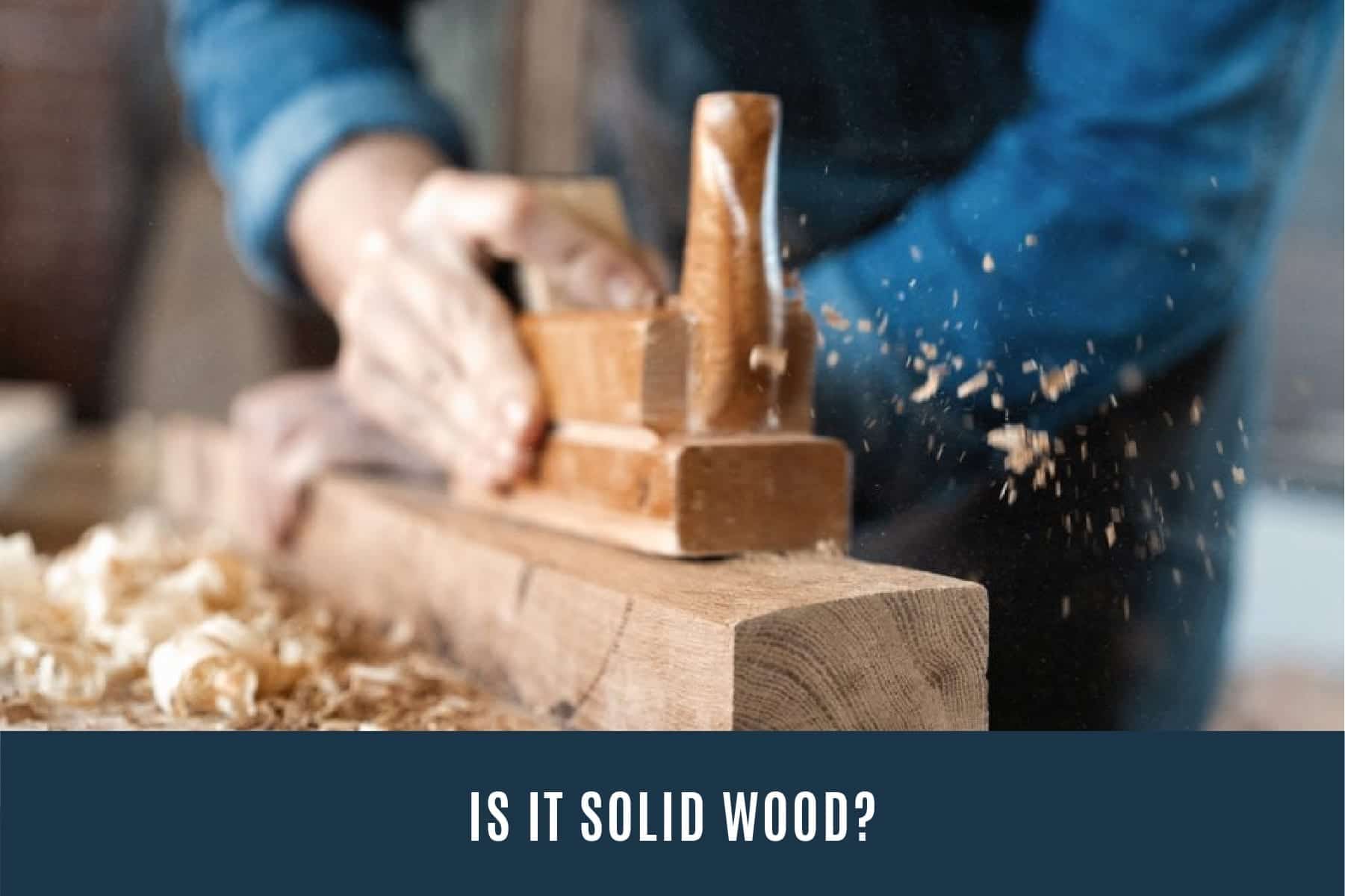
Does it have Mortise & Tenon Joints?
“Mortise and tenon” refers to one of the oldest and most solid joints used to combine separate pieces of wood, usually when they are at right angles to each other.
The joint uses two separate pieces:
One wood piece has a mortise hole – a cavity designed and shaped to receive the tenon.
The second wood piece has the tenon tongue – a wood projection designed to fit perfectly into the mortise.
Carpenters have used mortise and tenon joints for thousands of years because it is both simple and strong. Glue or dowels typically reinforce the joints.
Mortise and tenon joints are more difficult to spot, so you may need to ask if they were used on the furniture.

Does it use Dowels?
Dowels are another type of joint used to combine pieces of wood at right angles. It is similar to mortise and tenon joinery, and it is often used to help reinforce wooden joints.
How does it work?
Dowels are small, round wooden pins or pegs inserted into both pieces of wood. Each wooden piece has a hole drilled into it before the dowel is inserted. Glue is applied to the dowels to provide extra strength.
Dowels are one of the most effective and common ways to reinforce right angles, and using them helps furniture remain strong and solid.

Look for Dovetailed Joints
Dovetailed joints are another common joint used with right angles, and most often found in cabinets and drawers.
Dovetailed joints do not use any insertions or holes. Instead, the two pieces of wood are cut into trapezoidal shapes that lock together.
Like the other joints, dovetailed joints use glue to help cement them together. When the glue dries, you don’t need any screws or other fasteners. This is why dovetailed joints are ideal for drawers.
Dovetailed joints are often easier to see because the joint is on the exterior. If the wooden pieces are stained in different colors, the joint is especially easy to see.
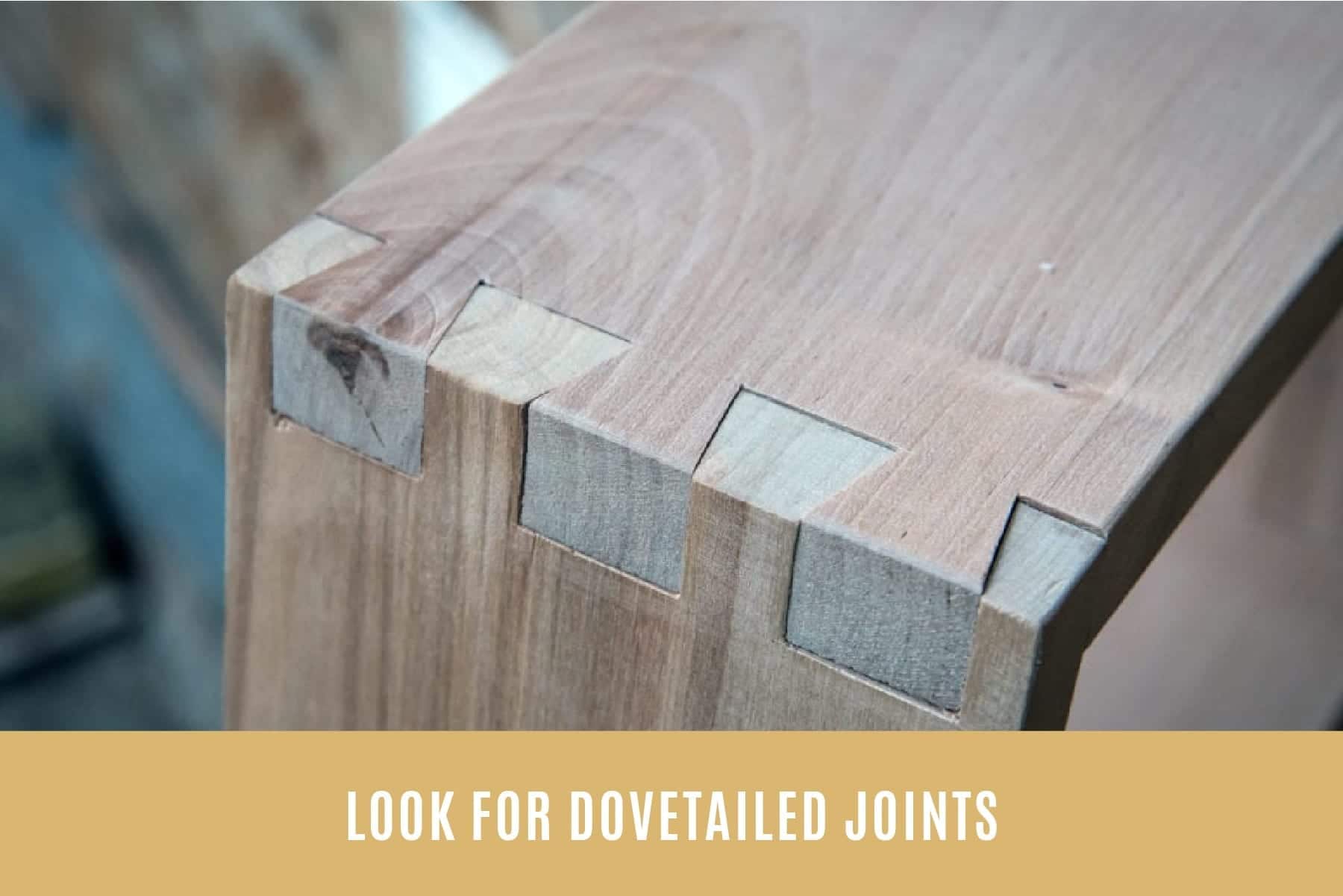
Does it have Reinforced Block Corners?
We have mentioned several reliable ways to join wood at right angles, but with larger and heavier pieces of furniture designed to hold significant weight, you need more reinforcement.
A common method of reinforcing the corners on wooden furniture is installing a piece of wood that joins the other two pieces by forming a triangle.
It is critical to understand what reinforced block corners do – they are not a joint, they simply reinforce!
Wooden furniture using only reinforced block corners to create the primary joint is guaranteed to fail because it lacks the core strength and stability that a true joint provides.
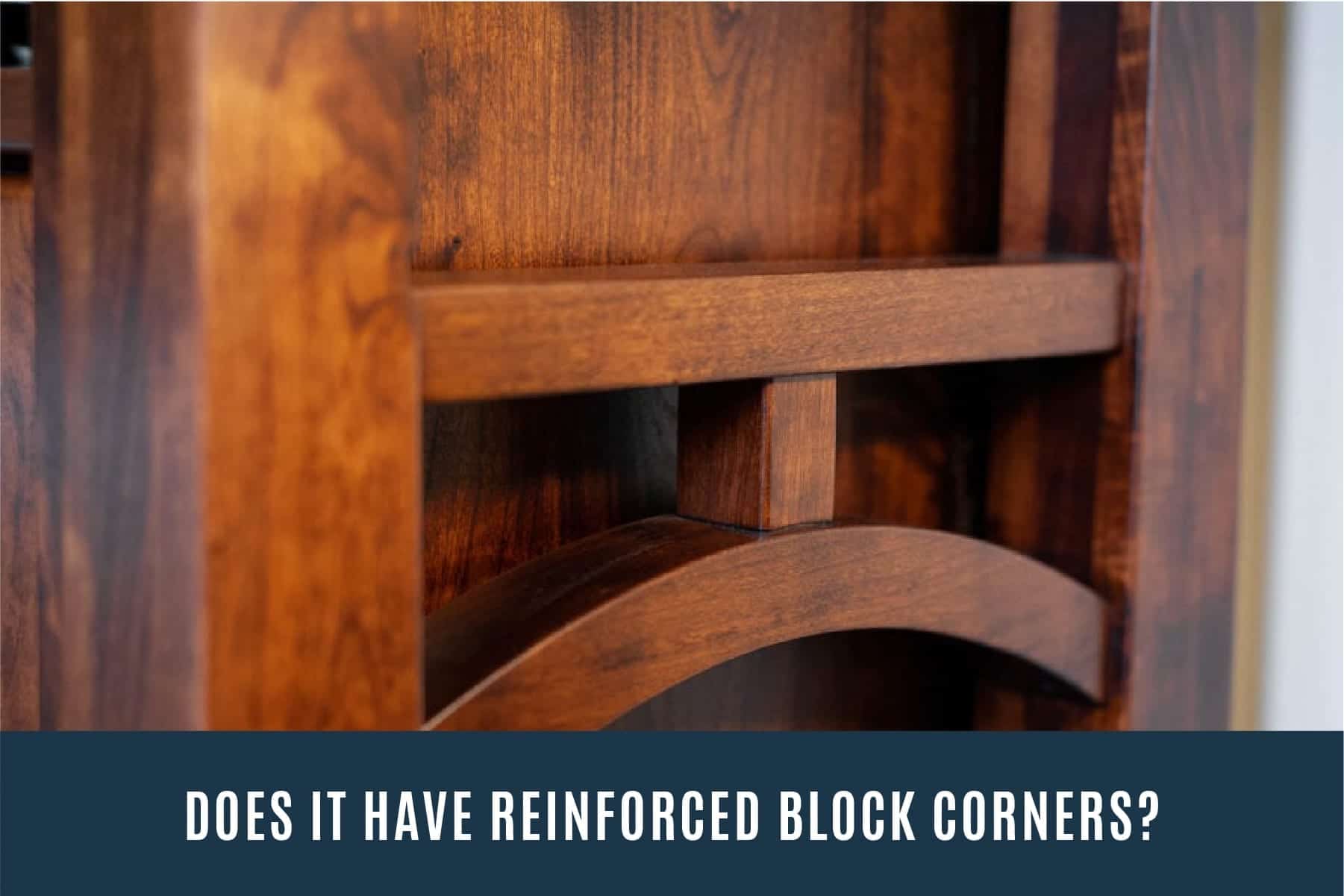
Do Drawer Glides Run Smoothly?
There is nothing as annoying as having a drawer or cabinet that doesn’t function properly.
When you open a drawer and look underneath, you should see the metal glide rails. These are the key to having a drawer that functions properly and smoothly.
How do you test the glide rails and drawers?
It’s pretty easy – simply open and close each drawer several times and watch and feel for any issues.
If the drawers don’t open or close smoothly, have gaps, or tend to stick, then move on to the next piece of furniture. It isn’t worth having sticky drawers for years to come!

Use the “Hip Test” to check for Wobbles
One of the biggest nuisances with new furniture is when it begins to wobble or be unsteady. You don’t have to take a level with you when you go shopping to solve this problem.
Instead, use the Hip Test to check for wobbles.
How does it work?
All you need to do is bump against the piece of furniture with your hip and watch closely. If it wobbles or moves, that’s a sign of something not being level or designed correctly.
If the furniture shows no motion, then it should be level and not wobble when you take it home.
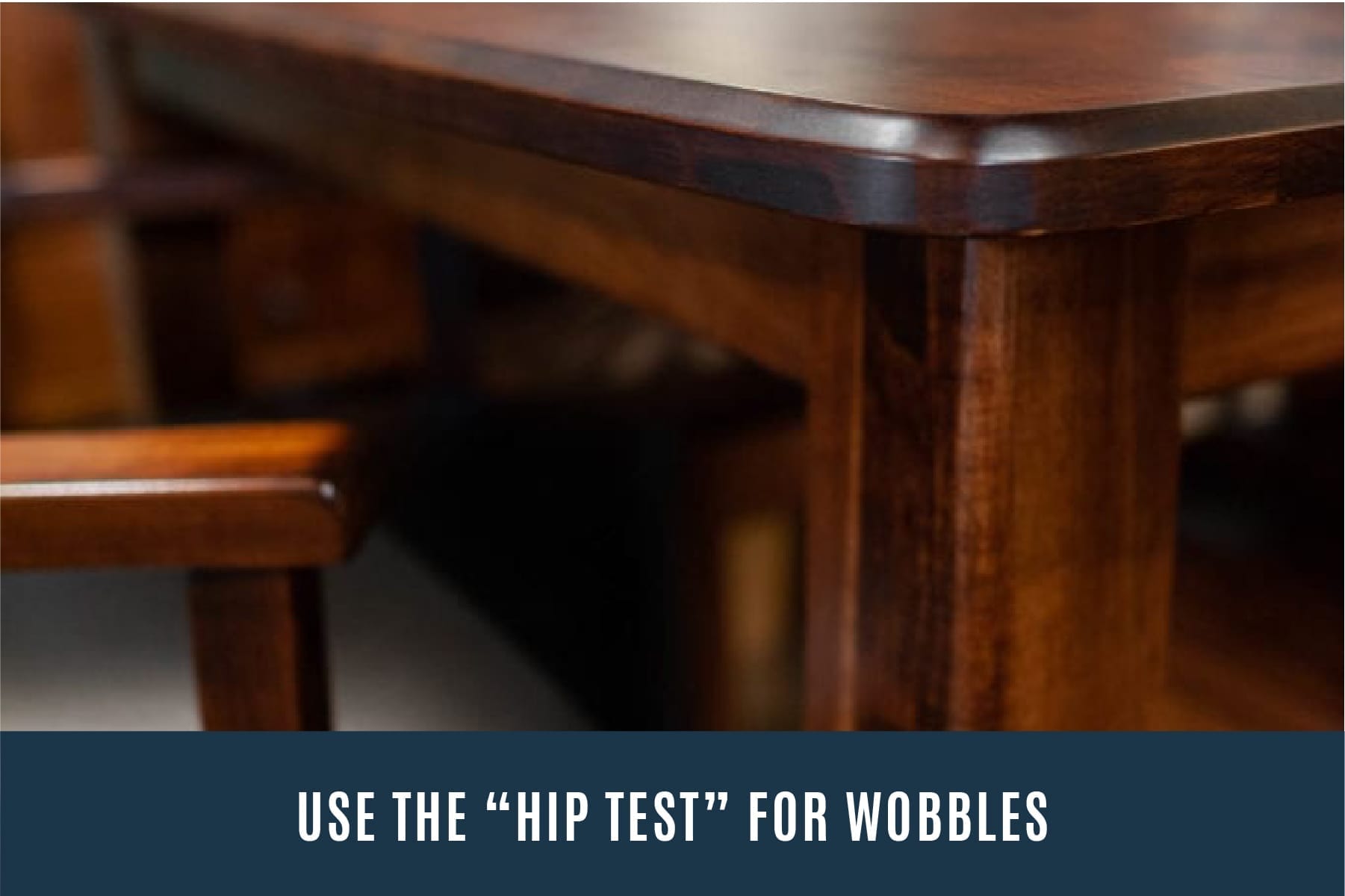
Check the Finish
The finish on the furniture is the final step before it is placed on sale, and it is an integral part of the furniture’s aesthetics.
A quality finish requires all the pieces to be sanded, smooth, and dust-free.
Dust, scratches, or other unwanted particles become more apparent after applying the finish to the furniture.
Look around the piece of furniture carefully, and feel it with your hands. Look for bumps, scratches, or other blemishes on the finish indicating it was not completed with care.
While checking the finish, you should also make sure no nails, screws, or glue is visible on the outside. While these items help strengthen joints, they should not be visible on the furniture’s exterior.

Look for Chips or Cracks
Reputable furniture stores look carefully at their finished furniture for chips, cracks, or other significant blemishes before it goes for sale. If something is wrong, they might discard the piece or offer it for a discount.
Sadly, not all furniture sellers are reputable, and some may try to sell blemished furniture for full price.
But even with reputable sellers, there is always the possibility a worker missed a blemish before the furniture was placed on sale.
Carefully look at the furniture for any abnormalities with the woodwork or stain, particularly highly visible parts, like the front.
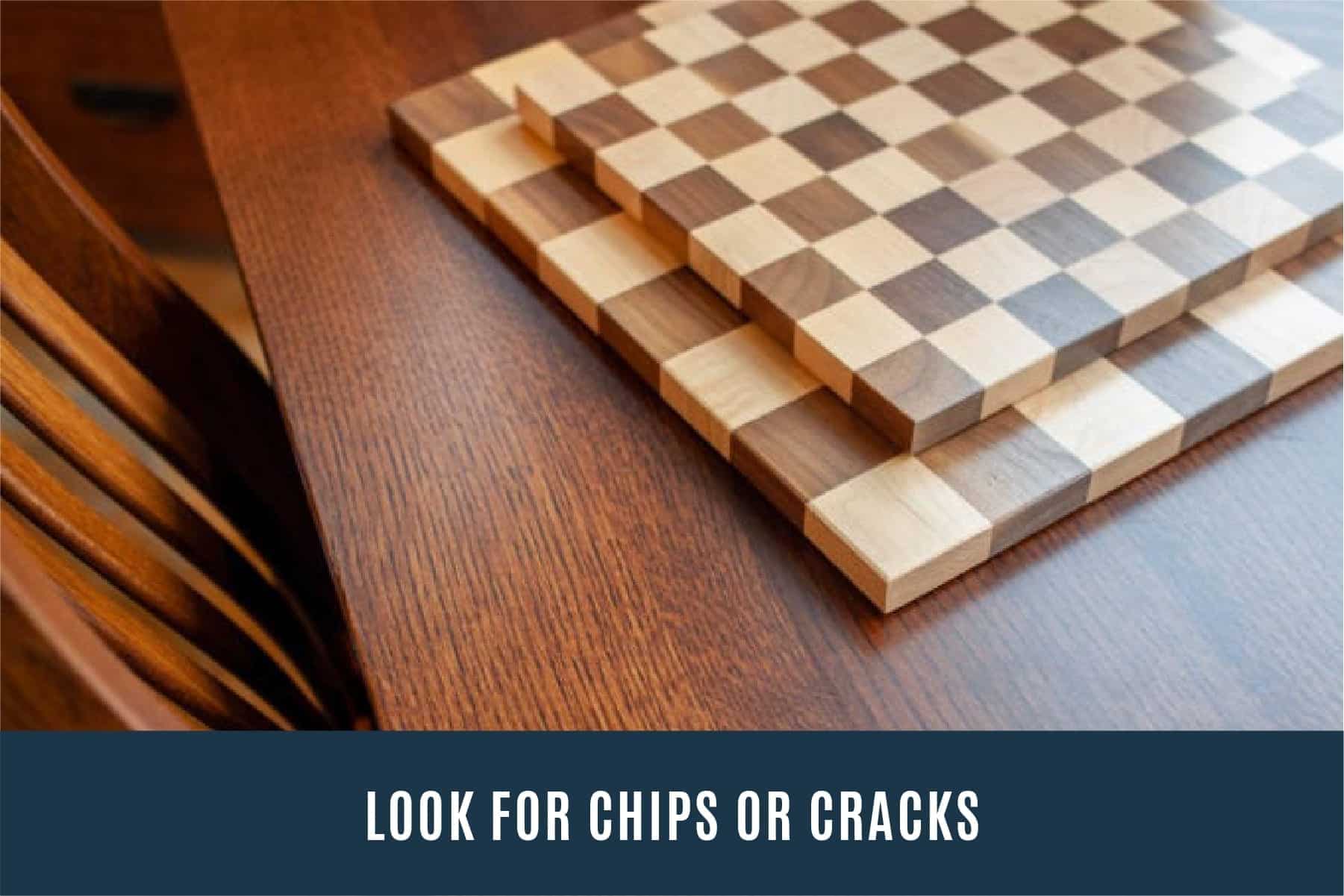
Is the Upholstery Sagging?
If you are buying furniture with upholstery, you will face an additional challenge – making sure the upholstery won’t wear out in a few short months
Unless you are an expert, it is difficult to judge upholstery by just looking at it. Even cheaper furniture has upholstery that appears neat on the exterior.
So how do you test upholstery?
The best way to test upholstery is to sit on it! You don’t want to harm the furniture by jumping or flopping on it, but you should be able to sit on it without the cushions or upholstery sagging.
Make sure you sit down in several different places during your test. Each point should have a similar pressure and resistance to your body.
You can also push down on the upholstery at different places with your hands. This allows you to feel the strength and quality of the upholstery and interior foam.
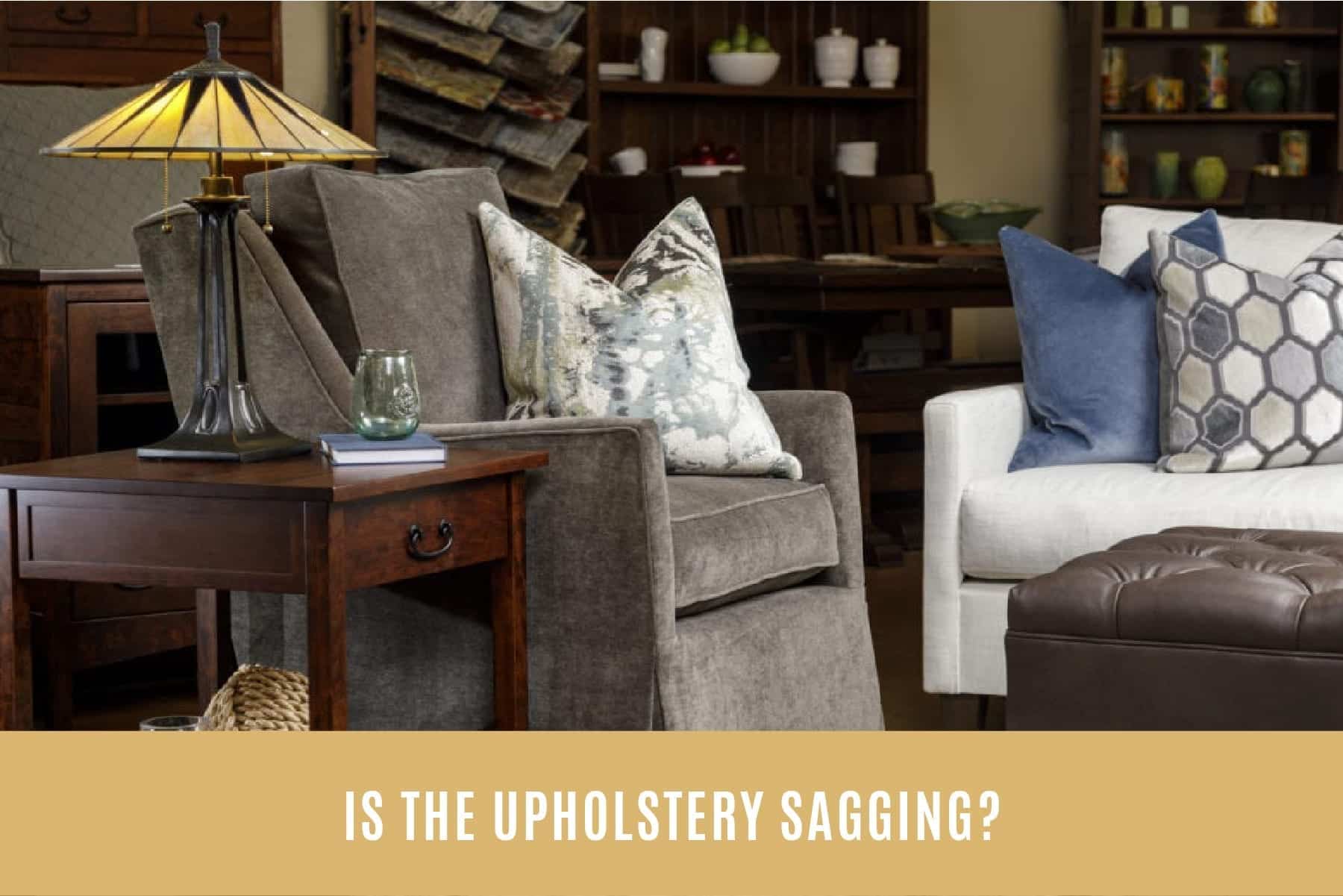
Is Low-density Foam Used?
Checking the foam density is difficult because it isn’t visible to you as you look at the furniture. However, the salesman should be able to tell you the foam density, or you can look at the furniture’s spec sheet.
What foam density do you want?
For quality furniture, the recommended foam density is a minimum of 1.8 pounds. Higher density furniture, such as 2.0-2.5, provides even more quality and long-term support.
If the furniture has removable cushions, you should also do a visual check on the foam in the cushions.
Remove a cushion and unzip it. The foam should be wrapped in fiber, and some also have an inner protective cover. This extra cover helps protect the long-term health of the cushion.
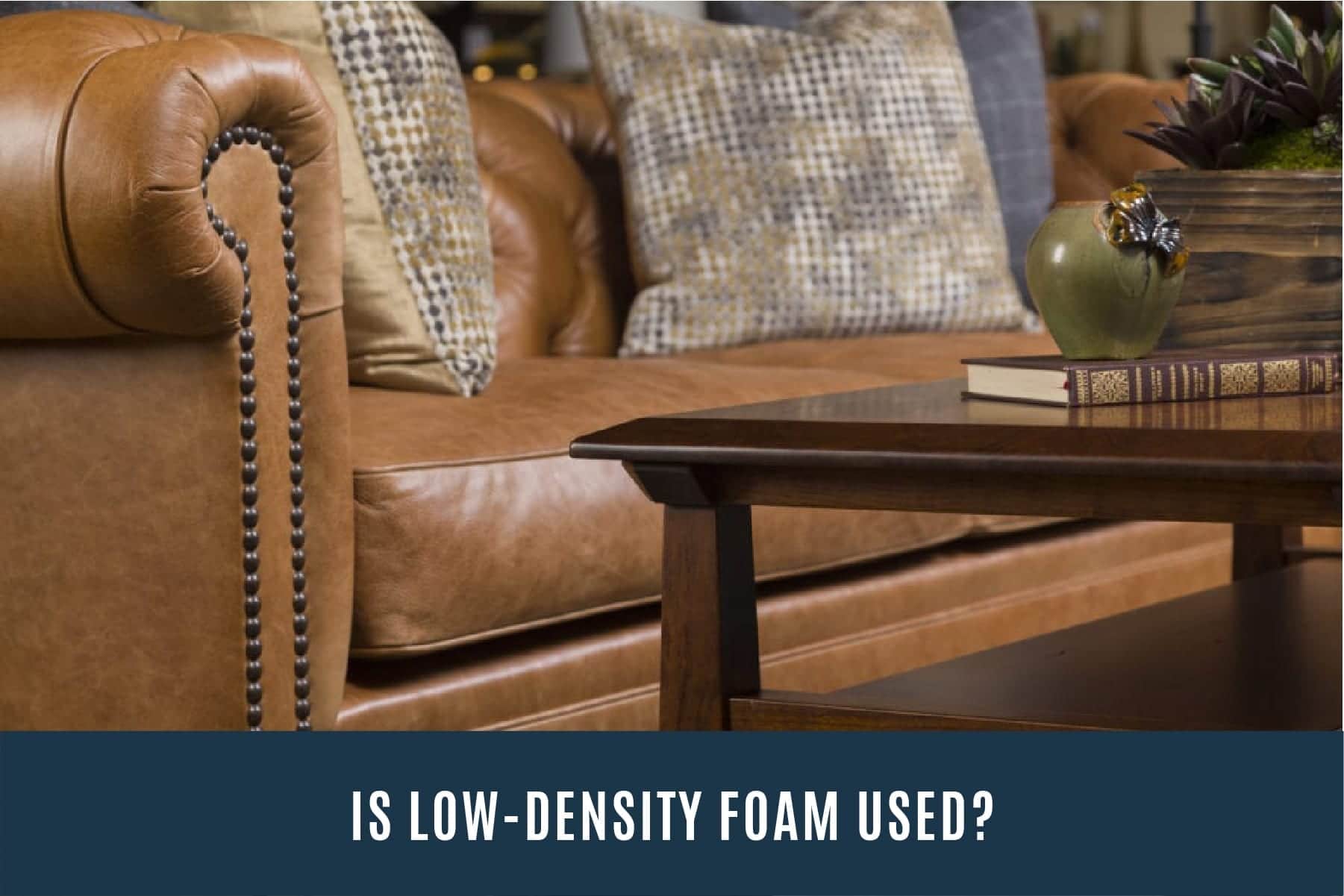
Check for Scratch Resistance
Scratch resistance is important for the long-term quality and beauty of your furniture. No wood furniture will stand up to severe misuse or mishandling, but quality wood furniture should be able to resist minor scratches.
How do you test the scratch resistance without harming the furniture?
Since you are looking at furniture you don’t own, you want to be very careful with the scratch test!
First, find a hidden or unexposed part of the furniture. Next, gently take your fingernail and draw a small line.
If this leaves a mark, scratch, or dent, then the overall piece of furniture is not satisfactorily scratch resistant, and it will show scratches and bumps quickly when used.

Watch for Click-bait Terms
We have all been sucked into reading an article or clicking a link because of click-bait. After all, that is click-bait’s purpose!
In the furniture world, click-bait terms are common. Most of these terms are applied to sub-par furniture to make them sound like they are either handcrafted or high-quality furniture.
What are some furniture click-bait terms?
- “Solid wood” or “hardwood” when solid wood was used only on the front and top, and plywood or veneer was used on the sides or back of the furniture.
- “Handcrafted” when most of the furniture was cut and assembled on an assembly line, and the only handcrafted part was the final assembly at the showroom.
- “High-quality” is a term that can be applied to anything, and is only as good as the furniture itself.
- “Quality wood” when random or different pieces of wood were used for a single piece of furniture.
- “Custom” when the furniture piece was mass-produced, and the customer had no say in its design or build.
Here is a good rule of thumb to avoid getting sucked into click-bait: When you are furniture shopping, ignore the descriptive terms used by the display or salesman. Terms like “cozy,” “warm,” “inviting,” and others can be used to describe any furniture or home decor.
Instead, focus on the actual pieces of furniture and use the tips described above.
You should also look at the furniture’s spec sheet. While spec sheets usually have descriptive language, they also have the important details like type of wood used, how it is made, foam density, etc.

Conclusion
If you want to buy high-quality or handcrafted furniture that lasts a lifetime, don’t be in a rush!
Looking carefully at furniture before buying it always pays. If you are careful, you will get furniture with better aesthetics, lifetime durability, and higher quality.
If you are looking for quality furniture, particularly Amish built furniture in Houston, TX, then contact the team at The Amish Craftsman today!
They focus on a truly customized furniture buying experience. With a showroom full of quality handcrafted wooden furniture, The Amish Craftsman offers furniture that truly last a lifetime.
We have more than furniture, too! We also carry:
- Arts and Crafts Rugs
- Craftsman Rugs
- Lighting
- Home Decor
- And furniture for every room in your home!
Buying custom furniture doesn’t need to be stressful; contact The Amish Craftsman today to begin your journey in building the room of your dreams!
Furniture Infographic
Download our infographic and take it with you the next time you go furniture shopping!



